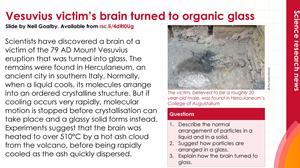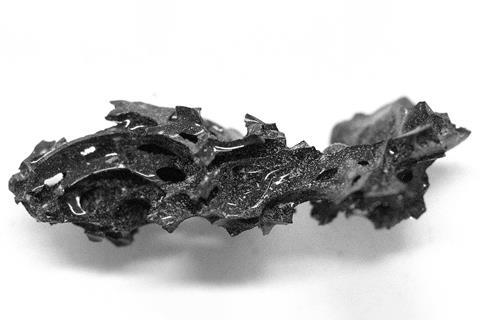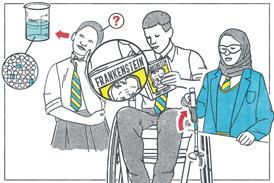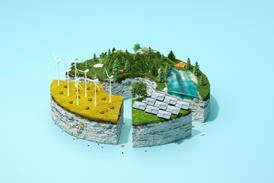Scientists uncover a 2000 year-old brain turned to glass
-

Download this
Use this story and the accompanying summary slide for a real-world context when teaching changes of state with your 14–16 learners.
Download the story as MS Word or PDF and the summary slide as MS PowerPoint or PDF.

Researchers have found a unique type of glass in the brain of a victim of the Mount Vesuvius eruption in AD79. This is the only known natural example of soft tissue turning into glass.
The team believes that the victim’s brain was rapidly heated to over 500°C when a hot ash cloud from the catastrophic Vesuvius eruption engulfed the Roman town of Herculaneum, near Naples in Italy. It then rapidly cooled when the cloud dissipated moments later. These conditions led to the brain tissue turning into glass.
Glassy grey matter
The rapid cooling of liquids to form a glass is called vitrification. When a liquid cools slowly, the molecules arrange themselves into an ordered crystal. But when the cooling is very rapid, the molecules can’t arrange themselves in order fast enough, resulting in a type of noncrystalline solid called a glass.
Researchers found fragments of glass measuring 2 cm to a few millimetres in size in the skull of the victim
Silica (sand) is the main component of most glass. Scientists have previously vitrified organic tissues in the lab, by cooling them rapidly from room temperature to ultra-low temperatures. This ancient brain tissue is the only known example of natural soft tissue vitrification.
Frozen in time
Scientists discovered the victim, a roughly 20 year-old male, in the remnants of a wooden bed in Herculaneum’s College of Augustalium. They believe he was a guardian of this public building dedicated to worshipping Emperor Augustus.
The research team was led by Guido Giordano from Roma Tre University. Researchers found fragments of glass measuring 2 cm to a few millimetres in size in the skull of the victim. Other parts of the victim’s body did not turn to glass. The team believes that the skull protected the brain from being totally destroyed by the heat.
This article is adapted from Ada McVean’s in Chemistry World.
Nina Notman
Reference
G Giordano et al, Sci. Rep., 2025, doi.org/10.1038/s41598-025-88894-5
Download
Summary slide with questions and the article for context when teaching 14–16 lessons on changes of state: rsc.li/3GYDeH5
Downloads
Volcanic ash cloud turned brain to glass student sheet
Handout | PDF, Size 0.28 mbVolcanic victim's brain turns to glass summary slide
Handout | PDF, Size 0.52 mbVolcanic ash cloud turned brain to glass student sheet
Editable handout | Word, Size 0.74 mbVolcanic victim's brain turns to glass summary slide
Editable handout | PowerPoint, Size 0.89 mb














1 Reader's comment